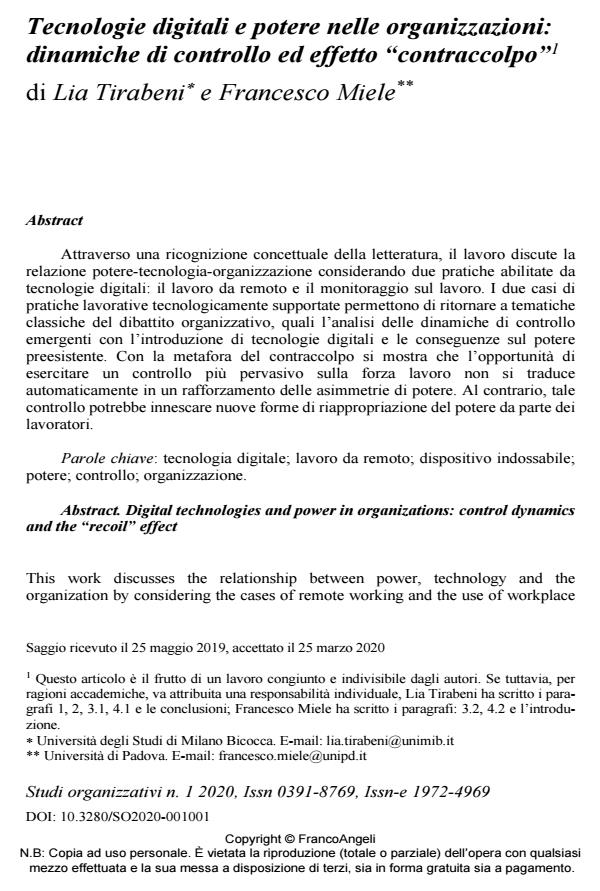Digital technologies and power in organizations: control dynamics and the "recoil" effect
Journal title STUDI ORGANIZZATIVI
Author/s Lia Tirabeni, Francesco Miele
Publishing Year 2020 Issue 2020/1
Language Italian Pages 29 P. 9-37 File size 369 KB
DOI 10.3280/SO2020-001001
DOI is like a bar code for intellectual property: to have more infomation
click here
Below, you can see the article first page
If you want to buy this article in PDF format, you can do it, following the instructions to buy download credits

FrancoAngeli is member of Publishers International Linking Association, Inc (PILA), a not-for-profit association which run the CrossRef service enabling links to and from online scholarly content.
This work discusses the relationship between power, technology and the organization by considering the cases of remote working and the use of workplace wearables. The two cases of digitally enabled work practices allow to think of, once again, a classical issue within the organization studies’ debate, namely the emergent control dynamics with the introduction of digital technologies and their consequences over prior established power. By proposing the "recoil effect" metaphor, the authors show that the opportunity to exercise a more ubiquitous control over the workforce does not automatically translate into a reinforcement of prior power asymmetries. Workers can take those technologies back too and, in turn, exert power on the other organizational actors.
Keywords: Digital technology; remote working; wearable device; power; control; organization.
- Connectivity and human capacity in digital transformation: the exploratory hypotheses of hyper industrial Emiliana Armano, Salvatore Cominu, Kristin Carls, Marco Briziarelli, in STUDI ORGANIZZATIVI 1/2021 pp.146
DOI: 10.3280/SO2021-001007 - Industrial democracy between neocapitalism and postfordism. The political and intellectual trajectory of Bruno Trentin (1926-2007) Francesco S. Massimo, in STUDI ORGANIZZATIVI 2/2024 pp.27
DOI: 10.3280/SO2023-002002 - The variable geometry of bargaining: implementing unions' strategies on remote work in Italy Anne-Iris Romens, Valeria Piro, Francesco E. Iannuzzi, in STUDI ORGANIZZATIVI 1/2022 pp.129
DOI: 10.3280/SO2022-001006 - Reintroducing technology to the coworking debate: prospects and problematics Maddalena Sorrentino, Lia Tirabeni, Maria Laura Toraldo, in STUDI ORGANIZZATIVI 2/2023 pp.70
DOI: 10.3280/SO2022-002003
Lia Tirabeni, Francesco Miele, Tecnologie digitali e potere nelle organizzazioni: dinamiche di controllo ed effetto "contraccolpo" in "STUDI ORGANIZZATIVI " 1/2020, pp 9-37, DOI: 10.3280/SO2020-001001